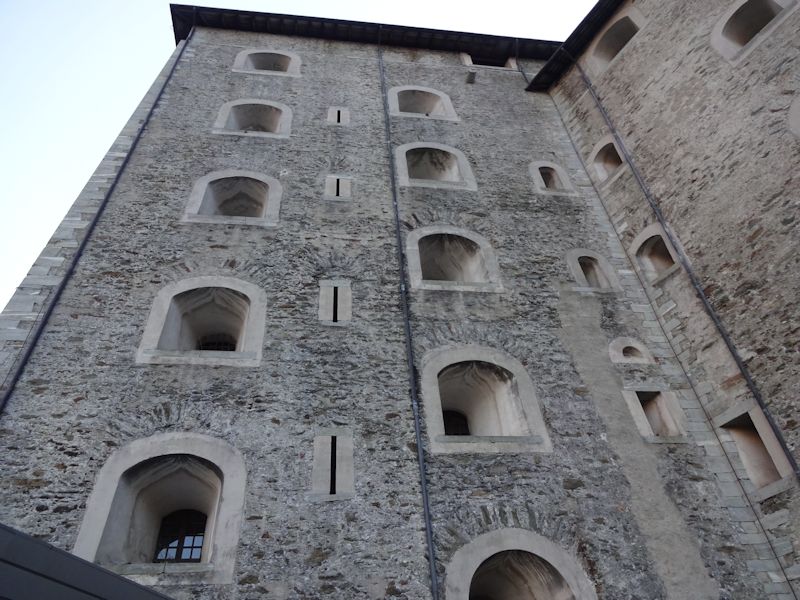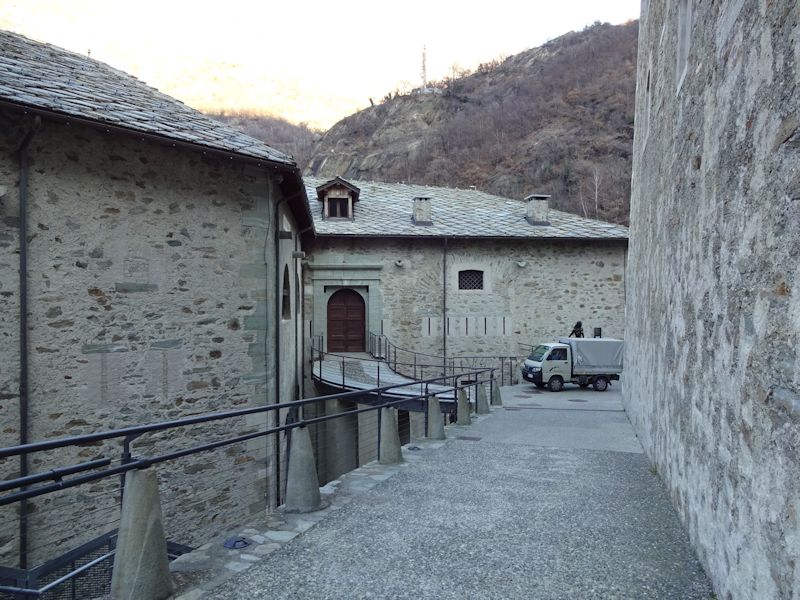You may not find this terribly rewarding unless you're included here, so this is a good time for casual and random browsers to turn back before they get too caught up in the sweep and majesty of the proceedings and can't let go.

We've come to find out more about Fort Bard, and after day trips to Ivrea and Turin, that's what we're going to do. For starters, we're walking down from the Casa Ciuca to the free lifts up to the top, 23 December 2015.
The first thing to note about the fortress on top of the big rock in the middle of the gorge is that, until the middle of the 19th century, anyone (or any army) going up the Aosta Valley from Italy to France or Switzerland, or vice versa, walked or rode on this street. There was no other way around that big rock.

Up we go (there may or may not be a charge for the lifts in high season, but they were free during our visit).

We've come out the southern entrance of the fortress at the top of the hill, and will now proceed down to the village.

The provincial road just below (the SS26) was carved out of the side of the big rock in 1856, and the railway to Aosta was put through in 1886. The autostrada or motorway, which enters its tunnel of the far side of the Dora Baltea river, was inaugurated in 1968. Prior to those momentous events, anyone traveling the 'Gallic Road' (Via delle Gallie) passed through the tiny village of Bard -- if the folks on the big rock were okay with that.

A winding road down the less interesting side of the rock -- we're presently facing south towards the next towns, Donnas and Pont Saint-Martin, and beyond that Ivrea and either south towards Turin or eastwards towards Milan.

There was a strong point built on this rock since the 5th century, which was replaced in the 10th century by a proper castle to control movements up and down the valley. It was operated by the local lords of Bard (see the Challant house below in the village), the preeminent amongst the powerful families in the region, until in the 13th century it came under the overlordship of the Savoyards from over the mountains south of Lake Geneva.

The old way up the hill, ooooof. After the spring snowmelt in 1800, Napoleon's army of 40,000 liberators trudged (in snow) over the Grand St-Bernard Pass in a surprise attack on Turin and the other Po Valley cities. The 400-man garrison of Austrian and Piedmontese troops, with only 20 cannons, held them up here for two weeks, and goodbye surprise attack! Eventually Napoleon's scouts found a way up out of the gorge and back down to the river farther south, the "Albard route" in the mountains above Bard, and his army proceeded to confirm his little republics all over Italy, often administered by his relatives, and he had the castle here destroyed, as with others along his route.

Back into Bard village. Now for a brisk walk up the business side of the fortress, cascading down the northern side of the rock.

Survivors of a nuclear attack (not the real title)

A model of the fortress, with Bard village and the river Dora Baltea. The present fortress was ordered up by Charles Albert, Duke of Savoy and King of Sardinia based in Turin, and built in 1830-1838 by the apparently famous fortress builder Olivero, facing northwards to prevent attacks down the Val d'Aosta from France via the Grand or the Petit St-Bernard Pass.
The fortress proper at the top has artillery ports in all directions (in the exhibition rooms at the top, the semi-circular cannon swivel tracks are still embedded all along the floor), whereas the casemates tumbling down the front are autonomous and provide additional artillery ports as well as mutually reinforcing small-arms ports covering both one another and the road up the hill from this side (at that time the state highway along the river did not yet exist).

Preparing for flight (not the real title)

Dashing up the hill. Each of these casemates presently houses museums, meeting rooms, offices, etc.

In modern times, Fort Bard was used as a weapons dump by the Italian army until it passed ownership over to the regional government in 1975. It was closed for major restorations in the 1990s and reopened in 2006 as the Museum of the Alps.

A very neat funicular railcar, alongside the original high mountain hut, the Bivacco Lampugnani, that was helicoptered onto Pic Eccles at 3860m on the Mont Blanc massif in the 1950s. It could hold six climbers if they were good friends.

Not too much farther now

Artillery ports out of the summit fortress

Fort Bard scenes


The view from Fort Bard up the Val d'Aosta: the Dora Baltea river and part of Bard village on the far right, the newer village of Hône, and the autostrada running up the middle. An information panel says that the Balteo Glacier occupied this valley up to 10,000 years ago, 5km wide and 600m deep, wow.

One of the two entrances to the top fortress

Back down we go; the rest of our party is waiting for us.



The funicular car descending to pick up some other eager seekers after knowledge and entertainment. Our room was in the beige building exactly to the left of the red base of the car, how convenient.

The view from the gun ports

A carefree peripatetic cat . . .

. . . that knows its way around.

The high street

The Via Vittorio Emanuele II

Bard street scenes

15th century wall paintings, or what's left of them

The Casa Ciuca below

The Challant House. The Challants had been hereditary viscounts of Aosta until 1295, when one of their number traded that title to the Count of Savoy in exchange for the barony of Montjovet, but the Savoyards were always aware that their sovereignty in the Aosta valley depended in large part on a good relationship with the Challant family; thus they took pains also to support the interests of rival families like the Quarts and Valleises, lest the Challants feel less need for the protection of their Savoyard overlords.

The Challant house is said here likely to have been built by Philiberto, Lord of Bard Castle, between 1487 and 1517, but at least at some periods the Castle must have been administered by castellans of the Counts of Savoy. (Eugene Cox has an interesting description of Count Amadeus VI's first visit to Bard Castle in 1351, The Green Count of Savoy, pp. 84-86.) The Challants were also lords of Fenis Castle farther up the valley.

I don't find an explanation here; if it's authentic, perhaps its Celtic.

The open courtyard of the Challant house onto the street; according to the info plaque, the courtyard was originally walled in but this front wall had been taken down at some point.


The Casa Ciuca tourist apartments (and enoteca, or wine bar)

-- Welcome home, young master.
 Dwight Peck's personal website
Dwight Peck's personal website










































